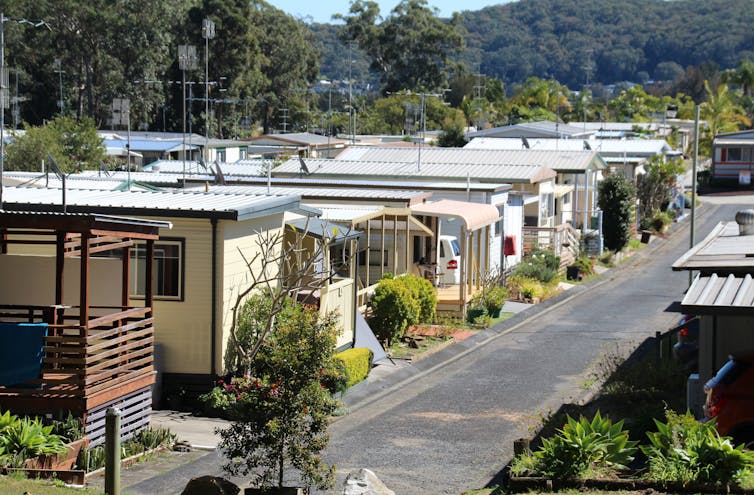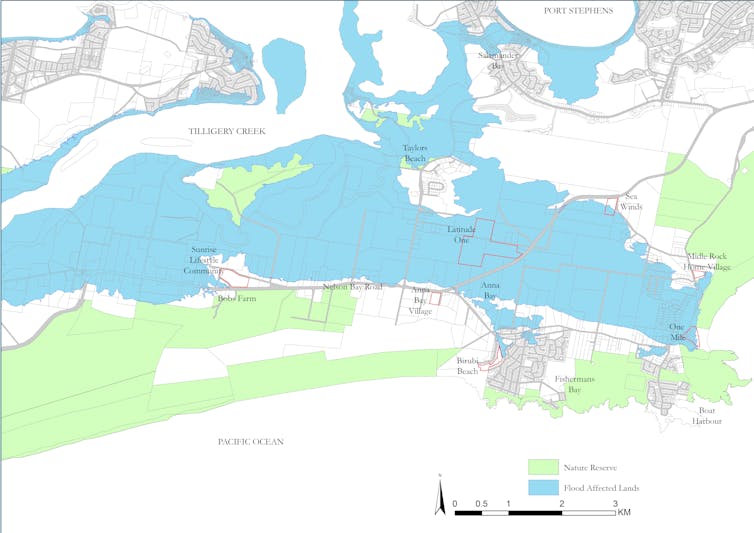 Author provided
Author provided
Some operators have predicted manufactured home estates will be the most popular type of retirement living in the near future, surpassing retirement villages.
But enthusiastic development of manufactured home estates as retirement communities is creating future problems for the older Australians who call them home. As explored in recently published PhD research in New South Wales, these home estates are often situated in locations affected by flooding and bushfire, and as the residents own the relocatable home, they bear the cost of these hazards.
What is a manufactured home estate?
Manufactured home estates evolved from caravan parks and have a similar business model. The operator owns the land and rents individual dwelling sites to residents who then purchase a relocatable home and pay a fortnightly/monthly rental to the operator. Rental returns to operators are very attractive, with listed operators openly extolling the financial performance of these investments.
Under NSW state planning legislation, where the research was conducted, manufactured home estates can be developed on land where caravan parks are permitted, including rural land, flood affected land and other hazard affected land. Such land is generally available at a cheaper price compared to sites zoned for residential uses. The result is medium density housing occupied by older Australians in locations where similar permanent residential development would not be permitted.
For example, an agglomeration of seven manufactured home estates, all or partially operated as retirement housing, are located around Anna Bay in the Port Stephens area. The two manufactured home estates most recently established were on rural land where development approval for caravan park had been received. This was then converted to development approval for a manufactured home estate. Neither property had been operated as a caravan park.
Four of these manufactured home estates around Anna Bay are wholly or partially on flood-affected land (see map below). This in turn restricts the development of permanent residential housing, yet these sites can be developed with manufactured home estates.
In other states, similar interaction between local and state government planning have facilitated the establishment of these estates on sites where caravan parks are permitted.
 Manufactured housing estates in flood affected regions. Author provided., Author provided
Manufactured housing estates in flood affected regions. Author provided., Author provided
Why this is such a problem
Manufactured home estates situated on hazard affected lands create problems for residents as they own their relocatable home and bear the cost of any damage. In the event of flooding or bushfire, residents could lose their homes unless insurance was available and affordable.
Read more: Vertical retirement villages are on the rise, and they're high-tech too
The proliferation of manufactured home estates in many coastal and rural locations, similar to Anna Bay, creates challenges for local governments. Such locations are distant from retail, commercial and community amenities, resulting in increasing populations of older people in locations away from required services.
Few of these locations have long-term strategic and infrastructure plans to accommodate medium density housing, let alone housing for older people. Residents without private transport have difficulty accessing services and amenities. As they age in place, their level of mobility can be expected to decline, highlighting the shortcomings of these locations.
Once they have moved in, residents may not be able to afford to relocate if they need to. Manufactured home estate living is promoted on the basis of its affordability, as the purchase price of relocatable homes can be lower than nearby permanent residential housing.
Many manufactured home estates are affordable, incoming prices in the region were as low as A$100,000 for a second-hand dwelling (advertised on Gumtree at the time of my research), with most around $350,000 to $450,000. However, prices can be much higher, with a new dwelling in a Port Stephens estate being advertised for $660,000. While I was undertaking my research in Port Macquarie, participants reported to me prices in excess of $800,000.
Read more: Retiree home ownership is about to plummet. Soon little more than half will own where they live
Many retirees can anticipate remaining in a manufactured home estate for 20 years or more. After 20 years, a relocatable home has minimal value, leaving residents with few assets with which to access residential aged care, if needed. When the total cost of house purchase and site rental for 20 years is compared with living in conventional residential housing, manufactured home estates living is less affordable.
Not all manufactured home estates are in hazard affected locations, but their ability to be located on sites where caravan park permission has been received creates a planning loophole.
This loophole has arisen through the interaction of local government planning controls with NSW State Environmental Planning Policies. Following rejection of a development application for a manufactured home estate at the local government level, operators are able to get approval at the state level.
The result is concentrations of older Australians living in hazard affected locations from which they may not be able to afford to leave.
Lois Towart, Lecturer in Property Economics, University of Technology Sydney and Kristian Ruming, Associate Professor in Urban Geography, Macquarie University
This article is republished from The Conversation under a Creative Commons license. Read the original article.
Image: https://www.diffen.com/difference/Manufactured_Homes_vs_Modular_Homes

